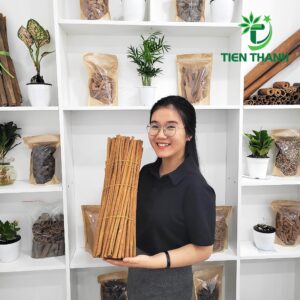 Vietnamese cinnamon—also known as Vietnamese cassia or Saigon cinnamon—is a fragrant spice harvested from the Cinnamomum loureiroi tree. It is known for its strong, spicy-sweet aroma, and is commonly used to add warmth and depth of flavor to foods and beverages.
Vietnamese cinnamon—also known as Vietnamese cassia or Saigon cinnamon—is a fragrant spice harvested from the Cinnamomum loureiroi tree. It is known for its strong, spicy-sweet aroma, and is commonly used to add warmth and depth of flavor to foods and beverages.
Origins of Vietnamese Cinnamon
Cinnamomum is a genus of evergreen trees and shrubs that contains more than 250 individual species. Several of these species are renowned for their highly aromatic bark, which is used to produce the cinnamon spice.
Vietnamese cinnamon (Cinnamomum loureiroi) is one of the finest, most prized varieties of cinnamon on the market. Compared to other species, Vietnamese cinnamon bark has the highest concentration of essential oils, giving it the strongest and most distinctive flavor.
In spite of its name, Saigon cinnamon is typically not found near the old city of Saigon. Rather, it is harvested from the lush, forested Central Highlands, where it thrives in the humid climate and hilly terrain.
The Central Highlands isare among Vietnam’s most fertile regions. Here, small-scale farmers grow valuable crops such as coffee, tea, cocoa, black pepper, and cinnamon. After it is harvested from the tree, cinnamon bark is dried in the sun until it curls into the recognizable “quill” or stick shape. Once dried, it may be ground into a fine powder.
History of Vietnamese Cinnamon
Cinnamon is one of the oldest known spices in the world, with a colorful history that dates back to antiquity. For thousands of years, only the wealthiest members of society could afford to indulge in the rich, spicy-sweet flavor of cinnamon. Historians believe that the ancient Romans and Greeks made offerings of cinnamon to their gods and goddesses.
Exports of Vietnamese cinnamon came to an abrupt halt during the Vietnam War. The trade embargo on Vietnamese cinnamon lasted for two decades after the end of the war, during which time the spice was unavailable in the United States.
Today, the popularity of Vietnamese cinnamon is on the rise. Many cultures around the globe adore the spice for its complex and robust flavor, which tends to be more pronounced than other varieties of cinnamon.
In Vietnam, cinnamon is used to deliver depth of flavor to a number of traditional dishes, such as phở. Vietnamese cinnamon is also commonly added to other soups and broths, sauces, baked dishes, teas, and other hot beverages.
Wellness Benefits of Vietnamese Cinnamon
Vietnamese cinnamon has been prized for its medicinal properties for thousands of years. Cinnamon is very rich in antioxidants, as well as antimicrobial and anti-inflammatory compounds.* During medieval times, cinnamon was used to treat a wide range of ailments, such as sore throats and coughs.*
Saigon cinnamon has a higher concentration of cinnamaldehyde than any other variety of cinnamon. This compound is not only what gives the spice its robust flavor, but also its ability to lower blood sugar.* Due to its uniquely high concentration, Vietnamese cinnamon may be one of the most effective varieties when it comes to reducing blood sugar.*
Vietnamese Cinnamon Tea
This fragrant infusion contains premium cassia cinnamon sustainably harvested from Vietnam.
Vietnamese Cinnamon Tea has a warm, spicy-sweet flavor profile. This is a full-bodied tea that tastes delightful served hot or over ice. Savor it sip by sip, and allow your mind, body, and soul to be invigorated.
Thanks for your attention!
Lisa (Ms)
Sales Manager
—————————
Email: Lisa@quetienthanh.com
Tel : +84-21-62201888 Phone/WhatsApp/Zalo: +84 383 234 316
Website: vietnamesecinnamon.com
————————————————
TIEN THANH AGRICULTURAL PRODUCTION CO.,LTD.
Office: Cau Vai Village, Mau Dong Commune, Van Yen District, Yen Bai Province, Vietnam.
Factory: Minh Khai Village, Quang Minh Commune, Van Yen District, Yen Bai Province, Vietnam.


